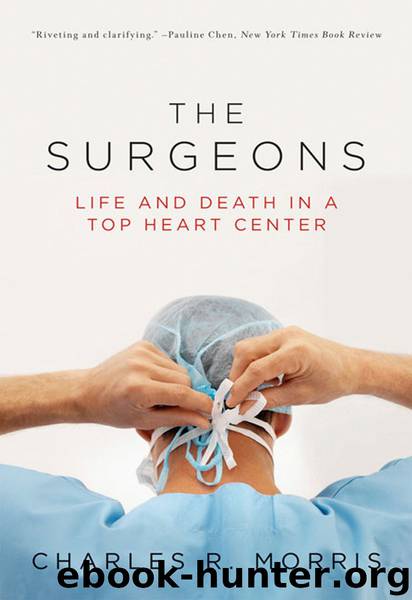The Surgeons: Life and Death in a Top Heart Center by Charles R. Morris

Author:Charles R. Morris [Morris, Charles R.]
Language: eng
Format: azw3
Tags: en
Publisher: W. W. Norton & Company
Published: 2009-02-13T05:00:00+00:00
I FOUND the M&Ms very impressive if deeply unsatifying. Within their own frame of reference, they were yet another example of the surgeons’ flat, factual, way of dealing with the world. Bad things happen. These are the bad things that happened on our last watch. Some of them were beyond our control. Some others we don’t understand. But these we could have and should have prevented.
The conclusions they reached were as varied as the incidents. Occasionally, there would be a decision to standardize a procedure—when to extubate, for instance—and a working group would be assigned to create a protocol. Occasionally, an incident would trigger an impromptu study—let’s step back, pull the last year’s cases and see if we can discern a pattern. Or someone would raise larger practice issues: “We’ve got to pay more attention to the medicine”—meaning being more alert to intestinal or other noncardiac complications. Or: “Are we withdrawing support too early?”
Most often, however, the lessons were left to be absorbed into the substrate of personal lore that guides each of the surgeons’ practices. That is the way the old violin maker’s shops worked: “We’ve tried that new maple for our backplates. It’s not bad, but we need to season it longer.” The overlay of science in heart surgery, of course, is much deeper than in instrument-making. There is an immense amount of literature on the circulating debris dredged up by a heart-lung bypass machine for instance. But the science doesn’t quite take you to the microlevel: is this patient a good candidate for an off-pump operation with this surgeon? The cardiac M&Ms, like all clinical training, start with those particularities, but then try to surround them with principles. Those were the moments at the M&Ms when the surgeons were most engaged: can we find a rule here?
Even as clinical exercises, however, the M&Ms have obvious deficiencies. Sherwin Nuland grumbles that, at least in larger general surgery shops, they have become “social-political extravaganzas,” demonstrations of “the art of elusiveness.” He fingers the practice of resident presentations as a central problem, since they often first see a patient in the OR and know little of the actual background of the decision-making. “You would sit there with your mouth dropping sometimes,” Nuland said, at the misinformation in a case report. That didn’t seem to be a problem at Columbia-Presbyterian, however—at least at the M&Ms I saw—since the responsible attendings almost always took over the detailed analyses of their own cases.
But from a broader perspective, in their role as the primary quality control tool, M&Ms seem quite inadequate. For one thing, they are almost completely unsystematic. The reviews are honest, and within the limits of the forum, reasonably thorough. But there is no database of outcomes and recommendations, no full-time “errors team” cataloging mistakes, seeking out patterns, and recommending changes. And they’re incomplete. At the M&M on the Erika Maynard case, for instance, there was no mention of the medication error the week before her death. To be fair, it happened when case responsibility had mostly shifted back to the medical side.
Download
This site does not store any files on its server. We only index and link to content provided by other sites. Please contact the content providers to delete copyright contents if any and email us, we'll remove relevant links or contents immediately.
| Administration & Medicine Economics | Allied Health Professions |
| Basic Sciences | Dentistry |
| History | Medical Informatics |
| Medicine | Nursing |
| Pharmacology | Psychology |
| Research | Veterinary Medicine |
Periodization Training for Sports by Tudor Bompa(8170)
Why We Sleep: Unlocking the Power of Sleep and Dreams by Matthew Walker(6618)
Paper Towns by Green John(5089)
The Immortal Life of Henrietta Lacks by Rebecca Skloot(4525)
The Sports Rules Book by Human Kinetics(4291)
Dynamic Alignment Through Imagery by Eric Franklin(4116)
ACSM's Complete Guide to Fitness & Health by ACSM(3989)
Kaplan MCAT Organic Chemistry Review: Created for MCAT 2015 (Kaplan Test Prep) by Kaplan(3939)
Introduction to Kinesiology by Shirl J. Hoffman(3725)
Livewired by David Eagleman(3683)
The Death of the Heart by Elizabeth Bowen(3551)
The River of Consciousness by Oliver Sacks(3538)
Alchemy and Alchemists by C. J. S. Thompson(3449)
Bad Pharma by Ben Goldacre(3355)
Descartes' Error by Antonio Damasio(3230)
The Emperor of All Maladies: A Biography of Cancer by Siddhartha Mukherjee(3064)
The Gene: An Intimate History by Siddhartha Mukherjee(3047)
The Fate of Rome: Climate, Disease, and the End of an Empire (The Princeton History of the Ancient World) by Kyle Harper(3003)
Kaplan MCAT Behavioral Sciences Review: Created for MCAT 2015 (Kaplan Test Prep) by Kaplan(2936)
